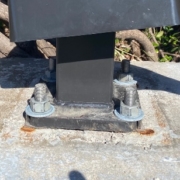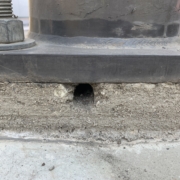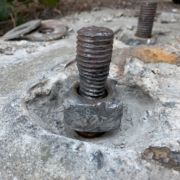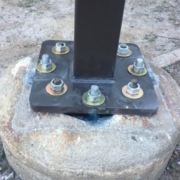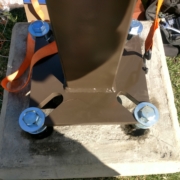How to measure anchor bolts.
Anchor bolts are commonly mis measured causing delays in installation or costly changes.
To get a printable PDF version of the Tech Tip, Click Tech Tip: Anchor Bolt Measurements
Quick Tips
3/4″ and 1″ are the common light pole anchor bolt sizes. Standard thread pitches are 3/4″-10 and 1″-8 (threads per inch). 3/8″, 5/8″, 7/8″, and 1-1/8″ do exist, they are highly uncommon in parking lot lighting. 1-1/4″ will occasional be used on larger and older poles.
When measuring anchor hardware, remember, the outside diameter of bolts and the inside diameter of nuts will measure smaller than the hardwares given size.
Wall thickness of a nut does not affect its size. Standard sizes are pictured. Thicker and thinner do exist.
These is a difference in the hardwares finish and this does affect the fitment. Anchor hardware should be galvanized.
Galvanized nuts are oversized to accommodate the thickness of the galvanizing. A zinc coated or raw nut will not
thread onto some thicker galvanized bolts depending on the thickness of the galvanizing.
Click on the picture to enlarge.
Steps to measure anchor bolts
- Clean any debris or rust from the bolt threads.
- Measure to the outside of the threads. Crest to Crest of the threads.
- Some bolts are tapered at the butt and will show significantly smaller that their nominal size.
- Take notes of bolt size in the field. Picture of tape measures and bolts are NOT a reliable source of information. This decision must be made in the field.
Steps to measure anchor nuts
- Remove any debris of the nut.
- If possible use a removed nut.
- We are looking for the Outside Dimension of the bolt that will thread into the nut. Root to Root of the nut threads.
- The root of most nuts can be seen on the top finish of the nut.
- Take notes of nut size in the field. Picture of tape measures and nuts are NOT a reliable source of information. This decision must be made in the field.
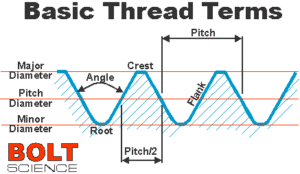
Light poles have become a source of pain for many in the electrical industry. We get calls from every level of the supply chain (manufactures, distributors, contractors, property managers, and owners). Most of which can be traced back to the following three issues.
1) The base plate of the new light pole does not match the bolt pattern of the anchor bolts in the concrete.
- Assuming that all similar sized poles have the same bolt pattern.
- This is common when replacing poles on an older property. Back in the day, bolt circles were generally larger than what is commonly used today. Even today, each pole manufacturer has their own base plate and anchor bolt pattern.
- Not checking all the pole locations in a project.
- This happens when replacing poles on a property that was built in phases. Not all poles on the property will have the same pattern, even if all the poles are the same size. It is critical to check all pole locations before ordering new poles.
- Differences in terminology
- Manufactures use terms differently to describe the same part. IE: Bolt Pattern, Bolt Square, and Bolt Circle.
- Anchor Bolt Pattern (Base Pattern)
- This is a generic term for the measurement of anchor bolts, in the concrete footing or the design of the light pole base plate. There is no standard measurement that goes with this term. When referring to bolt pattern, most companies use bolt circle, but some use bolt square.
- Bolt Circle
- The most common and accurate way to measure a bolt pattern of any design.
- The diagonal measurement of a standard four bolt pattern. This is also the diameter of a circle drawn through the center of all the bolts in the pattern.
- Bolt Square
- The side measurement of a standard 4 bolt pattern. This is the measurement of one side of the square.
- This only applies to four bolt square patterns and is not as accurate as using the bolt circle.
- Used when it’s hard to measure the bolt circle of a standing pole. It is critical to measure all four sides to ensure the pattern is square. Do not be alarmed when these measurements are not all the same.
- Converting Bolt Square to Bolt Circle
- Use this simple formula to convert a bolt square to a bolt circle. Bolt Square (BS) Divided by 0.707 equals Bolt Circle (BC) (BS / 0.707 = BC).
- If all Bolt Square measurements are not the same, convert the highest and lowest square measure and ensure your new pole fits this bolt circle range.
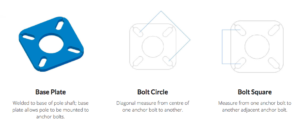
- Anchor Bolt Template Issues
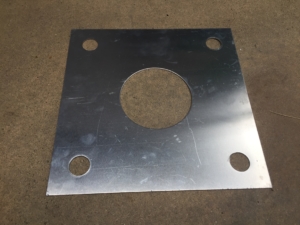
- The pole manufacturer can send or specify the wrong anchor bolt template. The contractor pouring concrete can use or make the wrong template. The template made can be weak or removed early and not hold the bolts square and vertical.
- Pole manufacturers supply a paper or thin metal template. From this, a stronger, usually plywood, template is made to hold the anchor bolts in position when concrete is poured. The plywood template must be left in place until the concrete is cured. A separate plywood template must be made for each footing being poured at the same time.
2) Light poles are commonly damaged during shipping.
- Shipping companies are not accustomed to handling light poles.
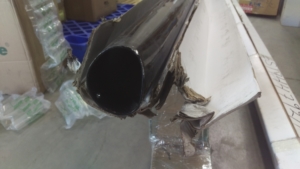
- Forklift operators insert a fork into the end of a pole and lift it from one end, bending, denting, and scratching the pole as they drag it out of a truck.
- Less Than Truckload (LTL) carriers are commonly used to ship small pole orders due to the cost of specialized or truckload shipments.
- LTL carriers transfer trucks multiple times during a shipment and are not accused to handling long pieces of freight, often casing damage.
- It is critical for light poles to be packaged properly for LTL freight, or shipped with a specialized truckload carrier.
3) Long Lead Times
- Small stock selection.
- Some pole manufactures stock poles in small number of sizes, and in dark bronze color only.
- If a pole is made to order, average lead time is over three weeks.
- If anything custom is needed, average lead time is over six weeks.
All of these problems can be prevented simply by being aware of how they happen.
Get in touch with our team if you have more questions or to share interesting light pole issue. We are always looking for new ideas.
A large area of copper theft is from a job site, shortly after new material is delivered. Common items stolen are copper wire spools, copper water pipe, fittings, and light fixtures. Basically anything made of aluminum, copper, or brass that is not nailed down. Most contractors value their tools and secure them in a job box, with cable, or secure storage bin; leaving the recyclable mettle out.
The most common security measure is a temporary fence with a chain around the gate. This works in some places, but most temporary fences have a weak point where they terminate into a wall or building. This joint can often be moved enough for a person to get through. The next week point in a temporary fence is the bottom rail. A 2 man crew can easily lift this fence up enough for the first to slip under, retrieve the wire, and slide it under the fence. At this point, the only thing the fence does, is protect against litigation liability from kids getting hurt on an unsecured job site. The next step can be quite effective, yet expensive.
Security guards can deter many thieves. Simply a marked security vehicle parked onsite is sometimes enough to keep the low grade thieves away. Unfortunately, guards are human and fall into a predictable patrol pattern or even a nap in their vehicle. One guard can only effectively watch one side of your job site at a time. Larger sites require more guards or risk having large sections of the site unprotected for a predictable time. We get regular reports of copper theft from a guarded site. The thieves case the site for one night, learn the guards patterns, then get in during an unguarded window. Judging by the amount of damage, the thieves must have been onsite for some time, then leave during a later patrol gap.
One of the most effective security measure is to lock the new material in a secure building. Commonly the building under construction is not secure by itself, and not a good storage location for material. The next best thing for job site security is a temporary secure storage container. Commonly, this can be a converted sea container, box trailer, or retired service vehicle.
Large jobs that require a large amount of material stored for a good amount of time. A converted sea container is an excellent option. This is simply a used cargo container with added shelving and lighting. Standard locks can be easily defeated but a simple weld or bolt on box can make the container very secure. The down side to this solution is the cost of transporting the containers, and their storage between jobs. This is a sound investment for large contracting companies working on large projects.A retired service truck or box truck can be easily converted for onsite storage. The downside is this vehicle must legally be insured and registered. In many states, trailers have a one time registration fee and no legal insurance obligation; lowering costs. A box trailer that can be left onsite overnight, easily locked, and have many storage configurations to fit any need. The ease of transport that comes with a trailer makes it simple to take from job to job. The trailer can also be wrapped with the company information to serve as a billboard, attracting new clients.
There are many other ways to prevent theft, but these are the most common and effective ways we found. If you have any other products or ways to prevent theft, we would love to share them. Kurtis@LightPoleSystems.com
Light Poles are a crucial part of our lives lighting up our roads, parking lots and walkways; but they rust, fall down, get hit, blown over, and forgotten about.
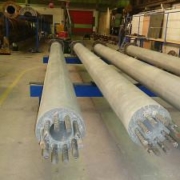 Light Poles provide light for our streets, parking lots, sports parks, walk ways, and children. A light pole is something that most people take for granted and maintenance personnel often do not regularly check.
Light Poles provide light for our streets, parking lots, sports parks, walk ways, and children. A light pole is something that most people take for granted and maintenance personnel often do not regularly check.
This is the first post in a series, focusing on light poles.
It sounds simple and uneventful, but I challenge you to read some of the up coming posts and they will make you look at light poles every time you walk through a parking lot. We will cover a range of topics, from how light poles are made, how they are installed, and how they get destroyed. Here is a small sample of some of the topics.
A light pole is just a light pole, Right?
Nope, there are numerous styles of light poles. Concrete, steel, aluminum, fiberglass, carbon fiber, or plastic. They can be round, square, tapered, octagonal, hexagonal, or fluted. They can be extruded, cast, poured, wrapped, cold rolled, welded, or stamped.
HOW LIGHT POLES ARE MADE
Lets look at a concrete, street light pole. They are constructed of concrete, steel cable, and steel tie wire. The cables are stretched the length of the pole. The tie wire is wrapped around the cable, then concrete is poured into the mold. The cables are stretched and tightened to add strength.
POLES GET HIT
 A concrete 20′ street light pole was hit on the side of the road. When hit, the concrete exploded. The pole came down on the Lincoln, poles always find the only car around, caving in the roof and preventing the doors from opening. Luckily, no one was in the car. But if they were, the fire department would need to come, and maybe even need to wait for a crane to come and pick the pole up off the car.
A concrete 20′ street light pole was hit on the side of the road. When hit, the concrete exploded. The pole came down on the Lincoln, poles always find the only car around, caving in the roof and preventing the doors from opening. Luckily, no one was in the car. But if they were, the fire department would need to come, and maybe even need to wait for a crane to come and pick the pole up off the car.
POLES RUST
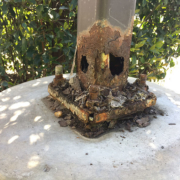 Light poles rust and fall in the middle of a crowded parking lot. When they are installed, contractors pack dry concrete, “dry pack”, under the base of the pole to help support the weight. This traps water in the pole, causing it to rust and fall. Always finding the most expensive car, and fall on that one.
Light poles rust and fall in the middle of a crowded parking lot. When they are installed, contractors pack dry concrete, “dry pack”, under the base of the pole to help support the weight. This traps water in the pole, causing it to rust and fall. Always finding the most expensive car, and fall on that one.
NOT ALL LIGHT POLES METAL
Composite light poles, also known as fiberglass , is one of those light pole materials not commonly thought of. When we think of fiberglass, we think of small row boats to wakeboard boats. Fiberglass was first used as home insulation in 1930, and combined with polyester resin in 1935. The first fiberglass dingy was made in Ohio in 1942 (Uses of Fiberglass, Johnson). Its light weight, and sturdy structure was improved and is now used in automobile body sections, aircraft parts, and light poles.
INSTALLATION
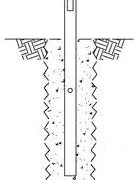 Fiberglass poles can be bolted to a footing or buried directly into the earth, known as direct bury. Direct burial means that the pole is buried directly into the earth, like standard telephone poles. When a light pole is installed using this method, the hole is dug, the pole is set and wired, then the hole is backfilled with the original material or concrete, depending on the specifications of the pole manufacture. This method can drastically lower the installation time when compared to the traditional method of pouring a footing, letting it dry, then installing the pole.
Fiberglass poles can be bolted to a footing or buried directly into the earth, known as direct bury. Direct burial means that the pole is buried directly into the earth, like standard telephone poles. When a light pole is installed using this method, the hole is dug, the pole is set and wired, then the hole is backfilled with the original material or concrete, depending on the specifications of the pole manufacture. This method can drastically lower the installation time when compared to the traditional method of pouring a footing, letting it dry, then installing the pole.
SOME FIBERGLASS DIFFERENCES
Steel poles are the most common poles on the market, but if they are not installed correctly, they rust and fall. Aluminum poles and galvanized steel poles do not corrode, but they are expensive. Fiberglass poles are priced slightly above steel poles, and do not corrode like traditional poles.
Fiberglass poles are up to 70% lighter than steel and aluminum poles (LightMart.com). This makes moving and installing fiberglass poles much easier than any other type of pole. Being non-conductive, fiberglass poles are also fully insulted.
MANUFACTURING
Fiberglass poles have two main components: fiberglass and resin. The fiberglass cords are made of 2,200 fiberglass strands wound together. The cords are dipped in a polyester resin bath then wrapped, many at a time, around a mandril. The steel mandril is tapered and makes the shape of the pole. The mandril spins and pulls the fiberglass cords around itself. The automated systems adjusts the speed of rotation and angle of the fiberglass cords to adjust the strength of the pole. When the fiberglass pole is the desired length and thickness, the mandril is pumped with steam to start the resin curing process. Within a few hours, the pole has cured and is ready to be pulled off the mandril. Cold water is piped into the mandril to make the pole removal easier. The mandril was lubricated before the fiberglass was wrapped so now it slides off the mandril with ease. Next the pole is sanded to the customers desired finish and the excess material is cut off the top and bottom of the pole. An automated router cuts the hand hole, fixture mounting holes, and below grade electrical conduit hole. Finally the pole is painted or powder coated any color the customer desires.
From a Role of flat steel to a finished light pole. Last week a team member posed a question, “How are steel light poles manufactured?”
Light poles have two main parts, the vertical tube and the base plate. The light fixture at the top of the pole is bolted to the tube and the base plate is bolted to a concrete footing in the ground. Their general construction is simple: a tube is welded to a cut base plate, a hand hole and fixture mounting holes are cut into the pole, then the pole is painted and installed.
This was too general for us. We wanted to know the full process of the pole was made. So here goes…
START WITH THE TUBE SECTION OF THE POLE.
Starting with a roll of flat steel sheet, there are two main ways to form the pole: cold rolled or pressed on a brake.
USING A BREAK
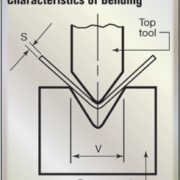 Using a metal breakA top tool presses the material into a matching grove in the bottom tool, bending the material to the desired degree. Bending the steel on a press brake allows the manufacture to quickly switch from 4” or 5” square to octagonal tapered tubing by simply uploading a new program to the machine.
Using a metal breakA top tool presses the material into a matching grove in the bottom tool, bending the material to the desired degree. Bending the steel on a press brake allows the manufacture to quickly switch from 4” or 5” square to octagonal tapered tubing by simply uploading a new program to the machine.
This process starts by cutting the steel to the proper length and width. For example, a 10’ tall, 4” square pole will start with a piece of steel, called a blank, 10’ long by 16” wide. The blank is then placed into a computer-controlled brake and shaped, one bend at time, until the tube is formed. Check out this video to see a break bend an octagonal pole.
CHECK OUT THIS VIDEO TO SEE A BREAK BEND AN OCTAGONAL POLE.
After the tube is bent, it is fed through an automatic welder the weld is ground smooth leaving a flush finish. Sometimes, the tube warps during the process and must be straightened. This is done by supporting the pole in two places, at least 5 feet apart, and using a press in the middle to straighten the tube.
This tube forming process can be done for virtually any shape tube. The number and degree of the bends are adjusted to make different shapes. To make a round tube the break is fitted with a rounded top and bottom die. Here is a video showing the process of manufacturing a round tube.
COLD ROLLING PROCESS
The cold rolling process is used in high volume mass production. A downside to this process is tube size cannot be changed as easily as they can be on a break. The cold rolling process starts with a roll of flat steel that is pre cut to the correct width. After going through a series of rollers that flatten the sheet, the steel is cleaned and the bending starts. For a square tube, the first roller bends the outside ends up about 45º. The next few rollers add two bends equally spaced down the center of the sheet and the four corners of the square tube start to take shape. Next, rollers on the out side of the tube make the final bends to close the gap and feed the tube past an anatomic welder. The excess weld bead is cut off, leaving a flat welded. From here the tube is passed through a cleaning solution and then a final set of finishing rollers to ensure the exact tube shape. An automatic saw then cuts the continuous tube into the specific length needed for the finished light pole. To finish the Poles, the manufacture cuts mounting holes and a hand hole according to the customer’s needs.
THE BASE PLATE
Manufacturing the base plate is relatively simple when compared to making the tube section. Most base plates start out as 3/4”-1” thick plate. Using a CNC laser table, water jet, or flame cutter, many base plates are cut out of one large plate of steel. The excess material can be recycled and reused in future steel products. Take a look at the below video to see how base plates are cut.
Finally the base plate is slid onto the tube and workers ensure the base plate is square to the tube. The seam is then welded on the top and bottom of the base plate. For high strength poles, gussets are added.
FINISHING
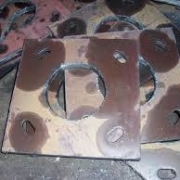 Because steel corrodes, the poles must be painted, galvanized, or powder coated. Painted poles are the most common due to its low cost and easy process. Powder coating is a high quality coating that can outlast conventional paint, but baking a full pole can be expensive. Galvanizing provides the most corrosion protection both inside and out side the pole and is the most expensive of the coating options.
Because steel corrodes, the poles must be painted, galvanized, or powder coated. Painted poles are the most common due to its low cost and easy process. Powder coating is a high quality coating that can outlast conventional paint, but baking a full pole can be expensive. Galvanizing provides the most corrosion protection both inside and out side the pole and is the most expensive of the coating options.
When a pole is painted, many times the inside of the pole is not coated. When the pole is installed, water can become trapped inside the pole, accelerating rust, and causing the pole to fail prematurely. It is difficult for painters to properly coat the inside of the pole, making galvanizing the best option, because the bath coats the inside of the walls as well.
If you have ideas for blog topics or general light pole questions, comment on this blog, on Facebook, on LInkedIn, or email us at kurtis@lightpolesystems.com

